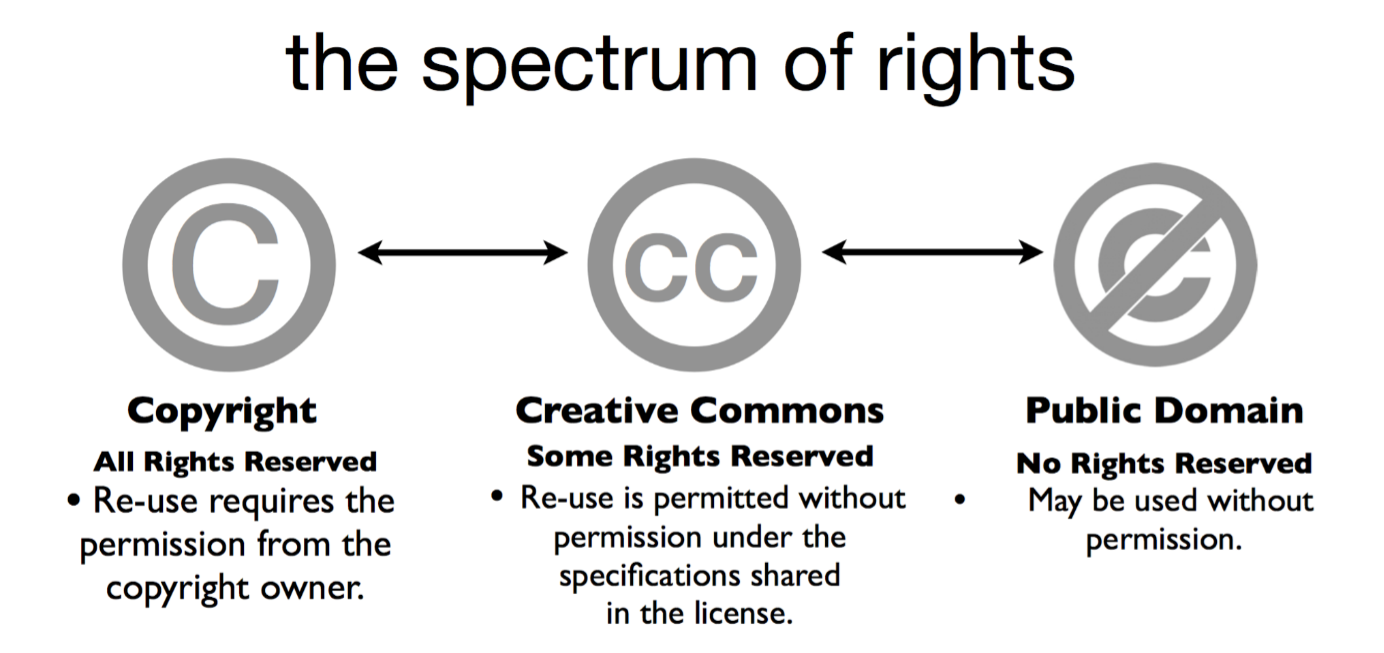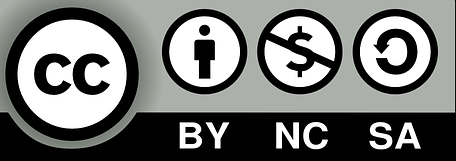1. Introduction
Creative Commons licenses provide a way to easily manage the copyright terms that attach to material, both creative and containing content, under copyright (Frequently Asked Questions - Creative Commons).
Copyrights range on a spectrum, from all rights reserved copyright to no rights reserved public domain. Although there are perhaps no rights reserved on a resource, it remains good practice to give credit to the source thereof, thereby also modelling to students how to avoid plagiarism by acknowledging the source of the knowledge.

![]()
http://tlinnovations.populr.me/copyright
2. Understanding the CC licence
There are six Creative Commons licenses, and they apply worldwide. In addition, there is also the “no rights reserved" option (CC0) that provides the choice to a copyright holder to opt out of copyright and database protection. In this instance, artists, scientists, educators or other creators place their work completely in the public domain without restrictions. (CC0 - Creative Commons)
Herewith a short explanation of the four symbols used in the licenses. For detailed descriptions of the six CC license options, visit the
Creative Commons website, or read the explanation by
Sara Hawkins on her
website or watch this
short video by Ylaluzsehacio.

BY
| Attribution only – Anyone who uses the copyrighted work should provide appropriate credit. This includes the name of the creator and attribution parties; a copyright notice; a license notice; a disclaimer notice; and a link to the material. With this license it doesn’t matter how you use or distribute the work, just as long as you give credit and indicate how you’ve adapted the work.
|

SA | ShareAlike – Once changes to the initial work was made, you must share the new work under the same license. This implies that your work carries the exact same license and you cannot permit others from changing or sharing your work.
|

NC
| Non-Commercial – Under the Creative Commons license, “commercial” is defined as “primarily intended for commvercial advantage or monetary gain”. (NonCommercial interpretation - Creative Commons) This implies that you may not charge for the work, nor put it up for sale or charge clients for new work.
|

ND
| No Derivatives – The work may not be changed in any way. No cropping, adjusting the colour, amending it in any way. No alterations to the work in any way.
|
Feel free to visit the Stellenbosch University Library
website for more information on open access and the benefits thereof.
3. Adding Copyright information to our documents at SU
As per communique sent in March 2021, lecturers can mitigate the concern about misuse and redistribution of module content uploaded to SUNLearn by making use of a
Creative Commons (CC) license:
“Creative Commons licenses give everyone from individual creators to large institutions a standardized way to grant the public permission to use their creative work under copyright law. From the reuser's perspective, the presence of a Creative Commons license on a copyrighted work answers the question, “What can I do with this work?"
(https://creativecommons.org/about/cclicenses/)
All Stellenbosch University content indicated under a CC license must make use of the following, most restrictive license:

Add the link below, along with the description of the CC license provided above, to your module framework. You can also add it as a label to your SUNLearn page (click here to read about labels)

(Module Name) at Stellenbosch University is licensed under a Creative Commons Attribution-NonCommercial-NoDerivatives 4.0 International License.
For further clarity you can also add the following notice to your module framework and SUNLearn page:
Copyright Notice/Kopiereg Kennisgewing
Material which is made available by way of an electronic database may be subject to certain licensing conditions. You may only use the material for your own private study and research at the University and not for any other purpose. Printed material is also only made available for class discussion, private study and research purposes. Further reproduction or distribution of such material is prohibited.
Materiaal wat by wyse van ʼn elektroniese databasis aan u beskikbaar gestel is, ag onderhewig wees aan bepaalde lisensievoorwaardes. U mag die materiaal slegs vir u eie private studie en navorsing aan die Universiteit gebruik en vir geen ander doeleindes hoegenaamd nie. Gedrukte materiaal word eweneens slegs vir klasbespreking, private studie en navorsingsdoeleindes beskikbaar gestel. Die verdere reproduksie of verspreiding daarvan is ontoelaatbaar.
With regards to lecture recordings, students must be made aware of the fact that all lecture materials, and lecture and audio recordings (regardless of the platform used) are the intellectual property of Stellenbosch University. Therefore, any lecture and audio recordings are subject to the copyright license and may not be reproduced or distributed. For example, these lecture-recordings may not be uploaded to a student's personal YouTube channel and made publicly available. Students may be held liable for copyright infringement. Students may also not record a lecturer, or any other staff member, without their consent. For further reading, please direct students to the following Innovus document:
https://www.innovus.co.za/assets/files/Downloads/110324_Final_IP_Policy_(Software_Amend)_(2).pdf
Lecturers are also reminded to adhere to DALRO and Copyright policies, as stipulated by SU.
Watch this webinar recording by Carol Kat (Head: Copyright; Trade Marks & Short Courses; SU) in which she answers frequently asked questions about the legitimate use of third-party content in online course material at SU. After watching this webinar recording, you should have a better understanding of what portion of an e-book you can share with students when you are allowed to upload/embed YouTube videos on your module page, and how (and why) to ask permission for sharing third party content.

